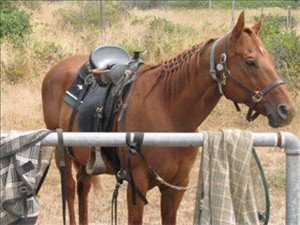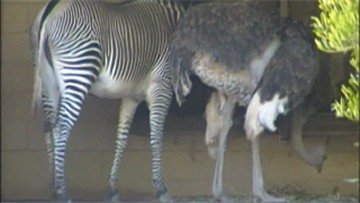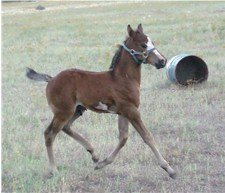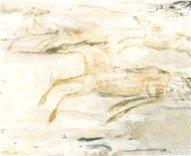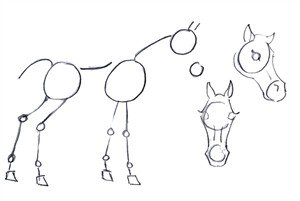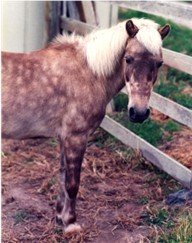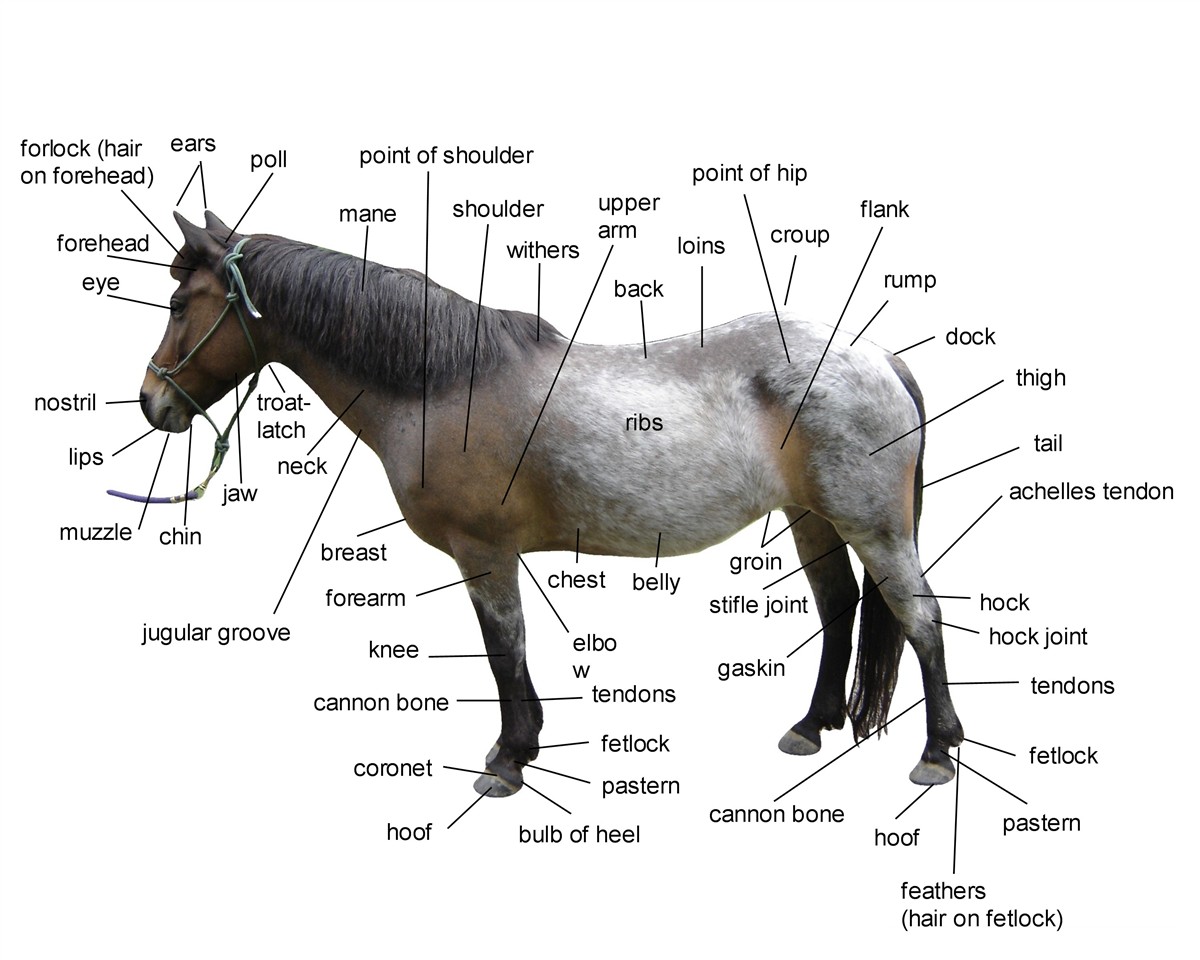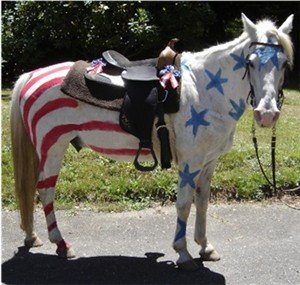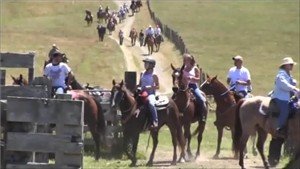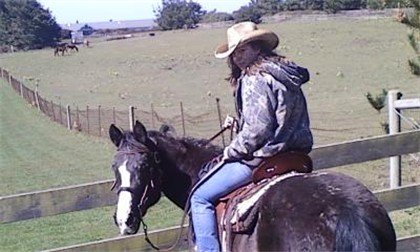Facts About Horses –
A Collection for
People Who Want to
Know
Looking for facts about horses? We've got ‘em! Need great horse facts for your next book report? Are you thinking about getting your first horse? Do you like learning about horses or just want to brush up on some equine trivia? You've come to the right place. Check it out!
A Horse is a Horse no Matter what You Call it
- Pony – A horse less than 56.2 inches at the shoulder
- Horse – A horse over 56.2 inches at the shoulder
- Mare – a mature female horse
- Filly – a young female horse
- Stallion – a mature male horse
- Colt – a young male horse
- Foal – a baby horse
- Gelding – A male horse that has been castrated
- Mule – Mom is a horse and Dad is a donkey
- Molly – female mule
- Hinny – Mom is a donkey and Dad is a horse
- Jack – An un-neutered male donkey
- Jenny or Jennet – female donkey
- Dam - A horse's mother
- Sire - A horse's father
Facts About Horses: Behavior
Horses are herd animals. This means that they are highly social and prefer to be in groups. A horse will always prefer to be with at least one other horse. It is important for their emotional, mental and psychological health… Like a dog on a chain… they go a little crazy when they are isolated!
Horses that are housed alone in a stall or a pasture will do better with a friend. If not another horse then another animal. What kinds of animals have been used for pasture mates? Goats, sheep, donkeys, llamas, cows and even chickens (in a stall/barn situation).
Horse vs. Man
When a 1000 pound horse kicks a 1200 pound horse it’s not usually a big deal. But when a horse kicks a 150 pound person…trust me, it’s a big deal! See equine safety for more on how to be safe around horses.
Horses are a prey animal. This means they are on the food chain for predators like wolves, mountain lions and bears. A horse’s first reaction to anything that frightens them is to bolt and run. Their second reaction is to kick or bite.
Horses also use kicking and biting to establish and maintain their pecking order with one another. Kicking and biting is an essential form of communication between horses. There is always a ‘lead’ horse in the group. The lead horse is the established boss.
In captivity it is usually a mare. In the wild it is often a stallion with a lead mare acting as second in command. Humans train horses to view people as ‘higher up’ on the chain of command to prevent getting kicked and bitten.

Facts about Horses and their Breeds
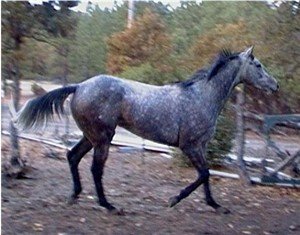 A purebred Thoroughbred
A purebred ThoroughbredThere are over 300 breeds of horses and ponies around the world. A recognized breed is a breed of horse that belongs to an association (like the American Quarter Horse Association or the Paso Fino Horse Association) with a breeding record and a stud book.
Horses registered with a breed association can be traced back to their breed foundation stallions. Pure bred horses will have their dam and sire registered with a recognized breed association.
There are some associations that will recognize ‘half-breed’ registry books. Meaning that at least one parent is purebred.
Purebred vs. Thoroughbred
A purebred is a horse with pure blood lines. A Thoroughbred is a breed of horse. Race horses are purebred Thoroughbreds.
There are also horse breed associations that are based on color rather than lineage; like the Appaloosa, Palomino and Spotted Horse Association.
All 300+ breeds of equines can be divided into 5 major types of horses. See horse types for more information.

World Record Facts about Horses
Surprising Facts about Horses
Mules are known to be sterile. But one Molly surprised the world and gave birth twice. One baby was named 'Once in a Blue Moon' and the second was called 'Lightning Never Strikes Twice'.
- The Tallest horses are Draft breeds (Big Jake is the world's tallest horse at 6 feet 10.72 inches or 20 hands 2 ¾ inches)
- The Smallest horses are Miniature horses (Thumbellina is the world's smallest horse at 17 inches or 4.25 hands)
- The Fastest horses are Thoroughbreds (The fastest speed ever reached was a ¼ mile run by filly a named Winning Brew in 2008. She reached 43.97 mph) Likewise the fastest 1.5 miles ever run was done in 2 minutes 22.8 seconds (at 37.82 mph) by a colt named Hawkster in 1989.
- The Oldest known horse breeds are: The Przewalski’s Horse for wild horses and the Arabian for domesticated horses.
- The Oldest horse in the world was an Irish Draught Gelding named Shayne. He lived to be 51 years old.
- The Highest Jump to be cleared by a horse was 8 feet 1.25 inches by a horse named Huaso ex-faithful in 1949.
- The Longest horse race in the world is called ‘The Mongol Derby’ it is a 5,177 mile, 10 day race that takes place in Mongolia.

Gestation Facts about Horses
The gestation period of a horse (length of pregnancy) is about 11 months. Draft horses can take as long as 11.5 months and donkeys a full 12 months. The birth itself is a fast event at about 10 minutes. Within 5-15 minutes the foal will try to stand.
Horses reach puberty at around 18 months, although it is not wise to breed such a young animal, as pregnancy places an undue burden on immature bones and joints that are still growing. Horses reach full maturity at 4-5 years of age.
Case of Horse Triplets:
There is one amazing case of a horse giving live birth to triplets. One foal lived 24 hours, one lived 4 days and the third miraculously survived. Lucky baby!
Horses can foal once a year and usually give birth to a single baby. Twins are seldom born to horses but do happen on occasion. Twins are small and have a low survival rate. Triplets are extremely rare and usually do not live.

Quirky Facts About Horses
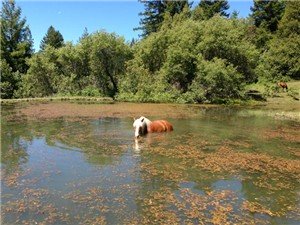 Horses enjoy water, but not all can swim
Horses enjoy water, but not all can swim- Horses use the long whiskers on their noses to feel the ground before they bump into it while grazing.
- The vast majority of horses can swim and many like to play in water.
- Cold weather makes horses wild and frisky.…it just does.
- Horses are incredibly curious about things they've never seen before.
- Horses learn both good and bad habits from one another.
- Horses don’t forget easily. They will remember wrong behavior from people…so watch yourself!
- Horses often sleep standing up. They use a small ligament to 'lock' their knees.
- Horses don't use their muscles to stand 'square and still', their body is built like a suspension bridge, perfectly balanced to stand without effort.
- Horses can see almost 360º around, except for a blind spot in front of their nose and directly behind their tail.
- Horses get jealous when you give one more attention than the other.
- Horses can suffer from depression, usually due to the loss of a close pasture mate.
- All horses know if a rider is experienced or not. Many will take advantage of a ‘newbie’…just because they can.
- Horses have a sense of humor. I have seen them play ‘tricks’ on one another.
- Almost all horses roll around in the dirt after a ride.
- The splint bone, ergot and chestnut (bony growth on the inside of the leg) are all thought to be remains left over from the horses three-toed prehistoric ancestors.
- Many horses do not step in rain puddles because they can't see how deep it is and don't want to risk a broken leg. Smart horse!

Interesting Facts about Horses Food and Care
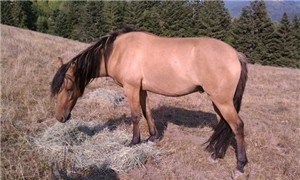 Horses have delicate digestive systems
Horses have delicate digestive systemsHorses eat about 3% of their body weight every day. A 1000 lb horse will eat 30 lbs of hay a day. Amazingly horses have very delicate digestive systems. When they get a stomach ache it’s called colic. Colic can be deadly to horses. Did you know that horses can not vomit?
The shape of their esophagus prevents it. Did you know that the simple act of feeding a horse one kind of hay one day and different kind of hay the next day can kill or cripple a horse? See equine nutrition for more facts on feeding horses.
Play it smart and only offer treats that are known to be safe for horses.
Some things that can or will make a horse sick: cabbage (OK in small amounts), lawn cuttings, tomato plants, potato plants, rhubarb, oleander, rhododendron, hemlock, fox glove and mustard plants.
Did you know that a horses hooves never stop growing? They must be trimmed on a regular basis. A horse that is ridden a lot can have the hooves worn down faster than the hoof can grow. That’s why people shoe horses.
The metal horseshoe is nailed directly onto the horse’s feet. Done correctly it does not hurt them. The shoe is nailed to the hoof wall. The hoof wall is akin to a humans fingernails. They can be trimmed and shod (have shoes put on) without pain.
Horse fact: their teeth never stop growing. They wear them down with use, like giant hamsters. You can tell a horse’s age by the rings, lines and shape of the teeth.

Facts about Horses in History
|
More Facts About Horses:
Home > Information on Horses > Facts About Horses
